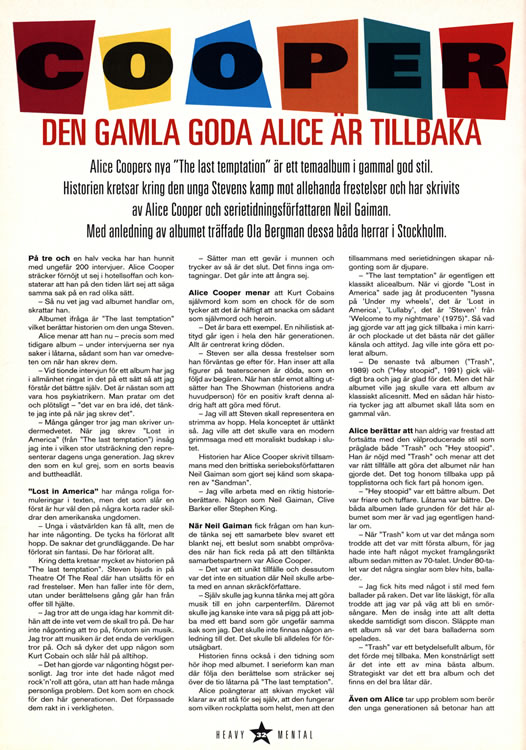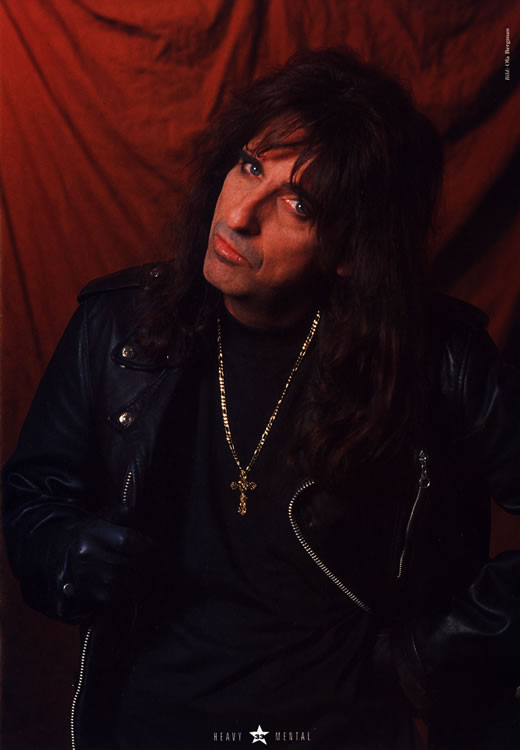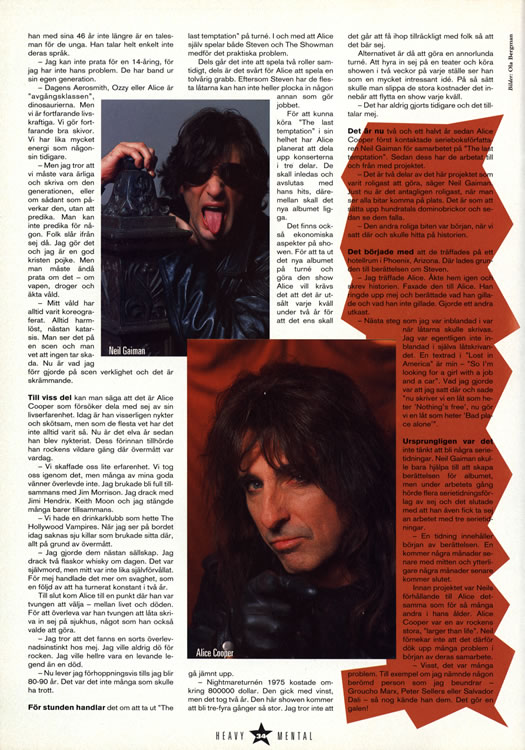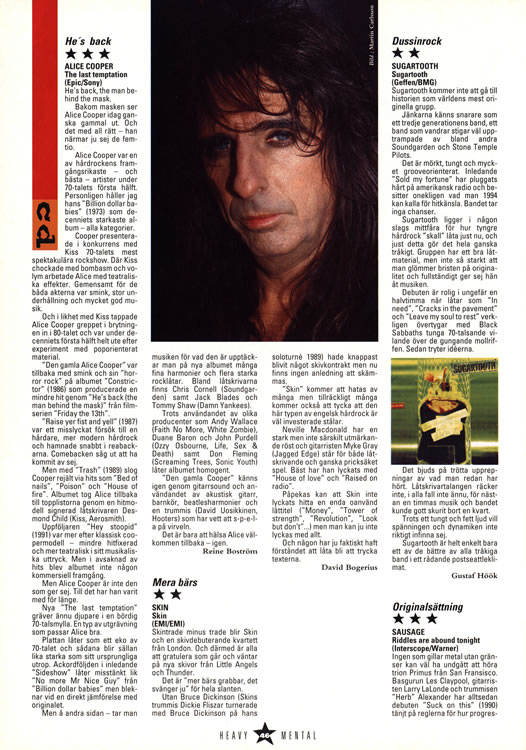Article Database
The good old Alice is back
Alice Cooper's new album, The Last Temptation, is a good old fashioned concept album. The story revolves around young Steven's struggle with many different temptations and was written by Alice Cooper and comic book writer, Neil Gaiman. To discuss the album Ola Bergman met up with the two gentlemen in Stockholm.
In three and a half weeks he’s done roughly 200 interviews. Alice Cooper happily stretches out in his hotel couch and states that in that amount of time he has learnt to tell the same things in a number of different ways.
"So now I know what the album's about," he laughs.
The album in question is The Last Temptation, which tells the story of the young boy Steven. Alice says that he now — just as with earlier albums — during the interviews, sees new things in the songs, things he wasn't aware of when he wrote them.
"By the tenth interview for an album I have usually focused on it in a way that makes it more understandable to myself. It's almost like going to the psychiatrist. You talk about it, and suddenly — 'that's a great idea, I didn’t think of that when I wrote it'.
"Many times I believe that you write subconsciously. When I wrote Lost In America (on The Last Temptation) I didn't realize to what extent it represented today's young generation. I wrote it as kind of a fun thing, like a Beavis & Butthead-song."
Lost In America has a lot of funny lines in it's lyrics, but what hits you first is how well it depicts the American youth in a few short lines.
"Young people in the West can get everything, but they have nothing. It seems like they have lost hope. They're missing the basic things. They've lost their imagination. They've lost everything."
This is what much of the story revolves around on The Last Temptation. Steven is invited into the Theatre of the Real where he is put through a streak of temptations. But he doesn't fall for them, but instead he goes from victim to hero during the course of the story.
"I think the young people today have reached a point where they don't know who to believe in. They have nothing to believe in, except their music. I believe that music is the only thing they really believe in. And then somebody like Kurt Cobain turns up and breaks apart everything.
"What he did was something totally personal. I don't think it had anything to do with rock 'n' roll, but that he had a lot of personal problems. It came as a shock to this generation. It brought them right back into reality.
"If you put a gun in your mouth and pull the trigger that's the end. There are no retakes. There's no way to regret it."
What Alice Cooper means, is that Kurt Cobain's suicide came as a shock to the people who think it's cool to talk about things like suicide and heroin.
"That's just one example. A nihilistic attitude runs through this whole generation. Everything circles around death.
"Steven sees all these temptations that he's supposed to give in to. He realizes that all the characters up there on the theatre stage are dead, as a result of their desires. When he opposes everything, he exposes The Showman (the story's second main character) to a positive force that he has never experienced before.
"I want Steven to represent a streak of hope. The whole concept is thought out that way. I wanted it to be a modern Grimm's Brothers tale with a moral message at the end."
Alice Cooper has written the story together with the British comic book writer Neil Gaiman, who has made himself a name as the creator of "Sandman".
"I wanted to work together with a true story teller. Someone like Neil Gaiman, Clive Barker or Stephen King."
When Neil Gaiman was asked if he was interested in a collaboration the reply was a total "No", a decision he soon reconsidered when he got informed that the collaborator was Alice Cooper.
"It was a unique opportunity and it wasn't a case of Neil working together with another horror writer.
"Personally, I would consider doing music for a Carpenter-movie. Whereas I probably wouldn’t be as inclined to work with a band that does about the same thing as I do. There would be no reason for that. It would be way too predictable."
The story is also inside the magazine which comes with the album, in the form of a comic, which allows you to follow the story that runs through the ten songs on The Last Temptation.
Alice points out that the record can stand on its own very well, that it works as good as any other rock album, but that it creates something that is deeper when combined with the comic book.
"The Last Temptation is actually a classic Alice album. When we did Lost in America I told the producer 'listen to Under My Wheels, that is Lost In America. Lullabye, that's Steven from Welcome To My Nightmare' (1975). So what I did was I went back through my career and picked out the best when it comes to feel and attitude. I didn't want to do a polished album.
"The two last albums, (Trash, 1989, and Hey Stoopid, 1991), sold very well and I'm happy about that. But this album I wanted to be an album in classic Alice-style. With a story like this I think the album should sound like an old friend.
Alice explains that he was never tempted to continue with the well produced style that ran through both Trash and Hey Stoopid. He is satisfied with Trash and says it was the right moment to do that album when he did it. It took him right back to the top of the charts and got him moving again.
"Hey Stoopid was a better record. It was a lot freer and tougher. The songs were better. Those two albums laid ground for this album which is more what I’m really about.
"When Trash came out there were a lot of people who thought it was my first release, because I hadn't had any really successful albums since the middle of the 70’s. During the 80's there were a few singles that became hits, ballads.
"I got hits with something like five ballads in a row. It was a little bit scary, because everybody thought I was becoming a crooner. But they didn't realize that all this went down at the same time as disco. If you released an album, it was only the ballads that were played.
"Trash was an important album, because it brought me back. But on an artistic level it's not one of my best. Strategically it was a good record and there are some good songs on it."
Even if Alice talks about the problems of the younger generation, he is emphasising that with 46 years under his belt, he is no longer a spokesman for the young. He doesn’t really speak their language anymore.
"I can't speak for a 14-year-old, because I haven't got his problems. They've got bands from their own generation.
"The Aerosmith's, Ozzy’s and Alice's of today, are the graduates, the dinosaurs. But we are still vital. We still make good records. We've got just as much energy as ever before.
"But I think we‘ve got to be honest and write about that generation, or about things that influence it, without preaching. People will act deaf otherwise. I do, and I'm a good Christian boy. But you still have to talk about it — about guns, drugs and real violence.
"My violence has always been choreographed. Always harmless, almost cathartic. You see it up on the stage, and you know no one is getting harmed. What I was doing before on stage is now a reality, and that is scary."
To a certain extent, you could say that this is Alice Cooper trying to share his life experiences. Today he is admittedly sober and caring, but as most people know that hasn’t always been the case. It’s now eleven years since he became a teetotaller. Before that he belonged to the wilder of the rockers, where excess was the standard.
"We got ourselves a little experience. We pulled through, but a lot of my good friends didn't survive. I used to get drunk with Jim Morrison. I drank with Jimi Hendrix. Keith Moon and I closed a lot of bars together.
"We had a drinking club called The Hollywood Vampires. When I look at that table today, there are seven guys missing that used to sit there, all because of excess.
"I almost joined them. I was drinking two bottles of whiskey a day. It was suicide, but in my case it wasn't as self-inflicted. For me it was more about a weakness, as a result of touring constantly for two years."
Alice finally reached a point where he had to choose — between life and death. To survive he had to commit himself to a hospital, something he also chose to do.
"I think there was some kind of survival instinct inside of me. I never wanted to die for rock. I wanted to be a living legend, rather than a dead legend.
Now I will hopefully live until I get to be 80-90 years old. Not many would have believed that would happen."
At the moment everything is centred around taking The Last Temptation on the road. But because Alice himself plays both Steven and The Showman there are some practical problems. Partly because you can't play two roles at the same time, and partly because it's hard for Alice to play a twelve-year-old kid. Steven also has the most songs, and he can't pick someone else to do the job.
To be able to play The Last Temptation in its entirety Alice has planned to divide up the concerts into three segments. They are to start and finish with his hits, and in between the new album will be performed.
There are also economical aspects around the show. To take the new album on the road and set up the show Alice wants to, he has to sell-out each night for two years just to break even.
"The Nightmare Tour in 1975 cost around $800,000. It made money, but it took two full years. This show will be three to four times bigger. I don't believe that we can get enough people to come and see it so that it will pay off."
The alternative is then to design another kind of tour. To hire a theatre and do the show for two weeks in each place, which is something he sees as a very interesting idea. That way you would cut out the big costs for moving around the stage show each night.
"It has never been done before, and it's appealing to me."
It has now been two and a half years since Alice Cooper first got in touch with comic book writer Neil Gaiman regarding their collaboration on The Last Temptation. Since then they’ve been working on it on and off.
"There has been two parts of this project that has been the most fun to do," says Neil Gaiman. "Right now is probably the most fun, when you see all the bits fall into place. It's like putting up hundreds of dominos and then watching them fall.
"The other fun part was the beginning, when we sat down and were coming up with the story."
It started with them meeting in a hotel room in Phoenix, Arizona. There the two laid the ground for the story about Steven.
"I met Alice. Went home again and wrote the story. Faxed it to Alice. He called me up and told me what he liked and what he didn't like. I did a second draft.
"The next step I was involved in was when the songs were about to be written. I wasn't really involved in the writing process. One line in Lost In America is mine – "So I'm looking for a girl with a job and a car". What I actually did was, I was sitting there and said "now let's write a song called Nothing's Free, now let's do a song called Bad Place Alone".
Initially there were no plans for any comic books. Neil Gaiman was only meant to help out with creating the story for the album, but during the work several comic book publishers expressed interest, so he also ended up taking on the job of creating three comic books.
"One comic contains the beginning of the story. One comes out a few months later containing the middle, and another few months later you get the end."
Before the project Neil's connection to Alice was the same as so many others of his age. Alice Cooper was one of rock's greats, "larger than life". Neil doesn't deny that because of that many problems presented themselves in the beginning of their collaboration.
"Sure, there were many problems. For example, if I mentioned a famous person I admire — Groucho Marx, Peter Sellers, Salvador Dalí — sure enough he knew them. That makes you go crazy!"
He’s Back!
***
ALICE COOPER
The Last Temptation
Epic/Sony
Author: Reine Boström
He's back, the man behind the mask. Today, behind the mask, Alice Cooper looks quite old. And there's nothing strange with that, he is after all approaching his fifties. Alice Cooper was one of hard rock's most successful — and best — acts during the first half of the 70's.
Personally, I rank "Billion Dollar Babies" (1973) as the strongest album of that decade — in all categories. Cooper presented, in competition with KISS, the most spectacular rock show of the 70's. When KISS was shocking with volume and being bombastic, Alice was working with theatrical effects. In common for both acts were makeup, great entertainment and very good music.
And in likeness with KISS, Alice himself lost the grip when taking the step into the 80's and during the first half of the decade he was totally gone, after experimenting with pop oriented material.
"The old Alice Cooper" was back with the makeup and his trademark "horror rock" on the "Constrictor" album (1986), which produced a minor hit with "He's Back (The Man Behind The Mask)" from the movie series "Friday The 13th".
"Raise Your Fist And Yell" (1987) was a failed attempt at a harder, and more modern hard rock and was quickly put in the sales bins. The comeback looked as if it was put to a halt.
But with "Trash" (1989) Cooper hit the bigtime thru hits like "Poison" and "House Of Fire". The album took Alice back to the top of the charts via a hit formula written by Desmond Child (KISS, Aerosmith).
The follow up, "Hey Stoopid" (1991), was made in a more classic Cooper style — less fixated on making hits, and much more theatrical in it's expression. But without any hits the album was no commercial success.
But Alice Cooper isn't the type that gives up. He’s been around too long to do so.
New album "The Last Temptation" digs even deeper in rich 70's soil. The kind of excavation that suits Alice well.
The record sounds like an echo of the 70's although the songs are rarely as strong. The chord structure of the opening song "Sideshow" sounds suspiciously like "No More Mr Nice Guy" from "Billion Dollar Babies", but pales in comparison to the original.
But, on the other hand — if you take the music for what it is, you will discover many nice harmonies and several strong rock songs on the new album. Amongst the writers you will find Chris Cornell (Soundgarden) as well as Jack Blades and Tommy Shaw (Damn Yankees).
Despite the use of different producers as Andy Wallace (Faith No More, White Zombie), Duane Baron and John Purdell, (Ozzy Osbourne, Life Sex & Death), as well as Don Fleming (Screaming Trees, Sonic Youth), the album sounds homogenic.
"The old Cooper" is recognized by the guitar sound, the use of acoustic guitars, children's choir, Beatles harmonies and a drummer (David Uosikkinen, Hooters) who has the sense to p-l-a-y on the snare drum.
The only thing left to do is to welcome Alice back — again.
The five albums that have meant the most to ALICE COOPER
- Pet Sounds (Beach Boys, 1966)
- Sgt Pepper's Lonely Hearts Club Band (Beatles, 1967)
- Aftermath (Rolling Stones, 1966)
- Having A Rave Up With The Yardbirds (Yardbirds, 1966)
- Forever Changes (Love, 1968)
Alice Cooper's most important albums according to ALICE COOPER
- Love It To Death (1971)
- School's Out (1972)
- Billion Dollar Babies (1973)
- From The Inside (1978)
- Welcome To My Nightmare (1975)
(Kindly translated from the original Swedish text by Christian Strandell, January 2020)








